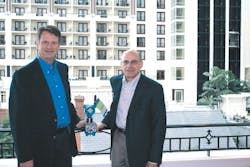There’s no doubt that industrial wireless technology remains squarely in the crosshairs for Emerson Process Management, the Austin, Texas-based automation vendor that has been one of the most aggressive promoters of the technology.
At the 2008 Global Emerson Users Exchange, Sept. 29-Oct 3, the company announced that it recently became the first company to ship products compatible with the new WirelessHart industrial standard. In fact, Emerson had installed 70 instruments that were operating on a WirelessHart mesh network throughout the Gaylord National Resort & Convention Center, near Washington, D.C, where the conference was held.
At the event, attended by about 2,700, the company also revealed the winners of its first annual Smart Wireless Innovators Applications awards for effective use of its Smart Wireless products. Further, the primary first-day event staged for trade press editors attending the Exchange was a “Real World Wireless” press conference, at which a half dozen Emerson customers described how they are using and benefiting from the company’s Smart Wireless technology.
Skyrocketing growth
“In the last 12 months, the wireless business for Emerson has absolutely skyrocketed,” said Emerson Process Management President and Business Leader John M. Berra, during his opening-day keynote address. Berra predicted that within the next few years, as much as 20 percent of all measurements made in plants will be made wirelessly.
The Sept. 29 address was the last Exchange keynote for Berra as business leader of the company. Effective Oct. 1, he turned over the reins as president and business leader to Steven A Sonnenberg, a 29-year Emerson veteran, who was also named executive vice president of the parent Emerson Electric Co. Berra will stay on with Emerson Process Management as chairman, focusing on strategic planning, technology, key customer relationships and organizational planning.
Berra is leaving operating leadership with Emerson Process in good shape. Sales are up 18 percent through three quarters of this fiscal year. If growth continues at the current rate, “we should be within shouting distance of growing a full billion dollars in one year,” Berra said in his keynote. Orders are also up, giving indication that next year should also be good.
Growth for the company has been across all of the company’s major product segments and in all areas of the world, he noted. In the past 12 months, Emerson has hired more than 1,200 new salaried employees and more than 1,800 hourly workers. “We believe that our PlantWeb architecture with Foundation Fieldbus, and now with wireless, have continued to deliver value to our customers. That’s why we have been growing so fast,” Berra told Exchange attendees. Since 2002, the company has increased annual research and development spending by an average of 12 percent, Berra added.
Why change?
In a subsequent keynote address, Sonnenberg said that many people have asked him about changes that he plans to make when he takes operating control. “Why change something that works,” he answered. “We plan everything at Emerson, including management changes. The company values longevity and I’ll still have John around as a mentor.”
Sonnenberg listed his four core values: provide quality products and services, continue to bring innovation, drive a sense of urgency and do things right. “I commit that I will use these values to drive my decisions,” he concluded.
At the “Real World Wireless” press conference later, representatives from six Emerson customers stood up to describe their application of the company’s Smart Wireless technology. These users included the two winners of the Smart Wireless Innovators Applications Contest. Croda Inc., a specialty chemical company, won the “Most Innovative” award for its use of wireless technology to measure temperature on moving rail cars at its Mill Hall, Pa., plant. CFM LAPEM, the Laboratory Analysis Group of Mexico’s Federal Electrical Commission, won the award for “Business Results” for its use of temporary wireless networks for measurements at 140 power plants, producing an increase in annual service revenues of $512,000.
Other companies describing successful applications of Smart Wireless technology included BP; Boise Inc.; Usinas Siderurgicas de Minas Gerais S.A., a Brazilian steel producer; and Genzyme Corp.
Two wires only
During the Exchange, Emerson also announced another new product, out of the company’s Micro Motion Inc. unit in Boulder, Colo., that was billed as “revolutionary.” The first two-wire Micro Motion Coriolis flowmeter is intended to expand the value of Coriolis to the wide range of applications that require loop-powered devices. Coriolis devices have traditionally required four-wire application. The new two-wire Coriolis meters are especially valuable for upgrading older loop-powered technologies to Micro Motion’s Elite line of Coriolis meters without incurring the cost of adding more power or installing new cabling, Emerson said.
“This is a product we’re very excited about,” said Micro Motion President Tom Moser, in reference to the company’s new two-wire Micro Motion 2200S transmitter. “The two-wire technology is really the next step in our goal to be one of the technology leaders and technology pioneers in the Coriolis field.” The 2200S becomes an important part of Micro Motion’s Elite sensor platform, Moser said. The 2200S “is not intended as a replacement for four-wire technology, but really to expand the use of Coriolis to more applications in the plant,” Moser added.
At the press conference, Tom O’Banion, Micro Motion director of global chemical industry marketing, discussed the experience of Momentive Chemical, a $2.4 billion company that was a beta customer for the two-wire 2200S. “We were all stunned at how simple and easy the installation was,” said O’Banion, noting that the unit was up and running in less than an hour. The two-wire capability of the device enabled Momentive to save eight hours of power wiring and an estimated $1,500 in cost for conduit and cable, O’Banion added.
Emerson Process Management
www.emersonprocess.com
About the Author
Wes Iversen
Managing Editor

Leaders relevant to this article:
